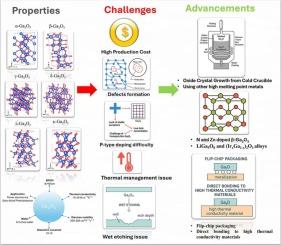克服材料限制的氧化镓在功率器件中的应用进展
IF 22
1区 材料科学
Q1 MATERIALS SCIENCE, MULTIDISCIPLINARY
引用次数: 0
摘要
近年来,氧化镓(Ga2O3)作为下一代超宽带隙(UWBG)半导体,由于其特殊的材料特性,即其宽带隙(~ 4.8 eV),高击穿电场,以及适用于高效率和高压电力电子应用,引起了越来越多的关注。这种日益增长的兴趣反映在越来越多的研究报告和组织专门的国际会议上。本文对Ga2O3的内在特性进行了深入的综述,并重点介绍了Ga2O3在材料生长、器件制造和性能增强方面的最新进展。重点放在目前阻碍基于ga2o3的器件大规模商业化的关键挑战上。其中包括实现稳定的p型电导率的长期困难,固有的低导热性,纳米和微空洞等晶体缺陷的存在,湿蚀刻工艺的局限性以及高制造成本,所有这些共同阻碍了设备的可靠性和可扩展性。我们还探讨了为应对这些挑战而开发的最新策略,包括实现p型行为的新型掺杂技术、热管理解决方案、缺陷钝化方法以及选择性蚀刻和表面处理的创新。此外,还讨论了涉及铝(Al)和铱(Ir)等元素的合金策略,因为它们具有调整材料特性、减轻限制和提高整体设备性能的潜力。通过巩固最近的进展和解决剩余的瓶颈,本综述旨在提供一个全面的观点,在Ga2O3的最新研究。它为学术研究人员和行业专业人士致力于实现商业上可行的基于ga2o3的电力电子器件提供了宝贵的见解。本文章由计算机程序翻译,如有差异,请以英文原文为准。

Overcoming material limitations progresses of gallium oxide for power devices applications: A review
In recent years, gallium oxide (Ga2O3) has garnered growing attention as a next-generation ultrawide bandgap (UWBG) semiconductor, owing to its exceptional material properties namely, its wide bandgap (∼4.8 eV), high breakdown electric field, and suitability for high-efficiency and high-voltage power electronic applications. This rising interest is reflected in the increasing volume of published research and the organization of dedicated international conferences. This comprehensive review provides an in-depth overview of the intrinsic properties of Ga2O3 and highlights recent progress in material growth, device fabrication, and performance enhancement. Emphasis is placed on the critical challenges that currently impede the large-scale commercialization of Ga2O3-based devices. These include the longstanding difficulty in achieving stable p-type conductivity, the inherently low thermal conductivity, the presence of crystallographic defects such as nano- and micro-voids, the limitations of wet etching processes, and the high fabrication cost all of which collectively hinder device reliability and scalability. We also explore the latest strategies developed to address these challenges, including novel doping techniques to realize p-type behavior, thermal management solutions, defect passivation approaches, and innovations in selective etching and surface treatment. In addition, alloying strategies involving elements such as aluminum (Al) and iridium (Ir) are discussed for their potential to tune material properties, mitigate limitations, and enhance overall device performance. By consolidating recent advancements and addressing the remaining bottlenecks, this review aims to provide a comprehensive perspective on the state-of-the-art in Ga2O3 research. It offers valuable insights for both academic researchers and industry professionals working toward the realization of commercially viable Ga2O3-based power electronic devices.
求助全文
通过发布文献求助,成功后即可免费获取论文全文。
去求助
来源期刊

Materials Today
工程技术-材料科学:综合
CiteScore
36.30
自引率
1.20%
发文量
237
审稿时长
23 days
期刊介绍:
Materials Today is the leading journal in the Materials Today family, focusing on the latest and most impactful work in the materials science community. With a reputation for excellence in news and reviews, the journal has now expanded its coverage to include original research and aims to be at the forefront of the field.
We welcome comprehensive articles, short communications, and review articles from established leaders in the rapidly evolving fields of materials science and related disciplines. We strive to provide authors with rigorous peer review, fast publication, and maximum exposure for their work. While we only accept the most significant manuscripts, our speedy evaluation process ensures that there are no unnecessary publication delays.
 求助内容:
求助内容: 应助结果提醒方式:
应助结果提醒方式:


